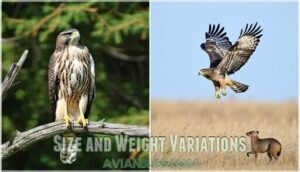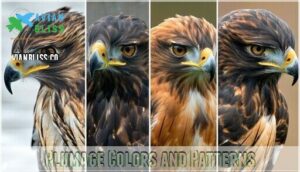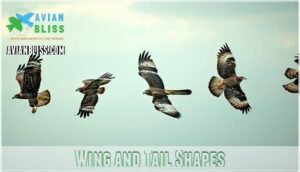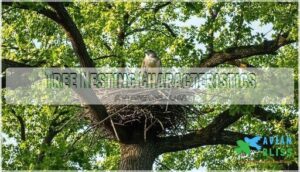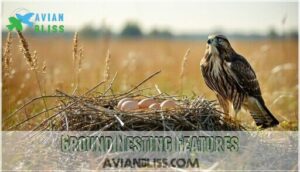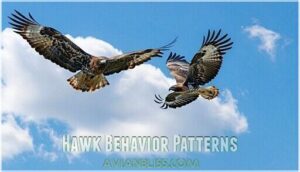This site is supported by our readers. We may earn a commission, at no cost to you, if you purchase through links.

Belonging to the family Accipitridae, hawks include buteos like the red-tailed hawk and accipiters like the sharp-shinned hawk.
These raptors boast incredible eyesight (think binoculars on steroids), sharp talons for capturing prey, and strong hooked beaks for tearing into a hearty meal.
They hunt everything from rabbits to reptiles, depending on species and habitat, which ranges from forests to deserts.
Ever seen a hawk spiraling upward? That’s thermal riding—nature’s version of a roller coaster.
Stick around for more about these winged wonders’ nesting, migration, and hunting secrets.
Table Of Contents
- Key Takeaways
- Hawk Types Classification
- Hawk Physical Characteristics
- Hawk Habitat Distribution
- Hawk Diet Foraging
- Hawk Behavior Patterns
- Frequently Asked Questions (FAQs)
- What do hawks eat?
- What are the different types of hawks?
- What are the physical characteristics of hawks?
- How do you identify a hawk?
- What does it mean when a hawk hangs around your yard?
- Is seeing a hawk a good or bad omen?
- What attracts hawks to your yard?
- Can a hawk pick up a 10 lb dog?
- Is seeing a hawk good or bad?
- What is a hawk in slang?
- Conclusion
Key Takeaways
- You’ll spot hawks by their sharp talons, hooked beaks, and keen eyesight, making them powerful aerial hunters.
- Hawks thrive in diverse habitats like forests, grasslands, and urban settings, showcasing their adaptability.
- They eat a varied diet of mammals, birds, reptiles, and insects, using precise hunting techniques like soaring and raking.
- Hawk species like red-tailed and sharp-shinned show unique physical and behavioral traits tailored to their environments.
Hawk Types Classification
You’ll discover that hawks belong to the family Accipitridae, but scientists classify them into distinct groups based on their hunting styles and physical features.
The main categories include true hawks (Accipiter genus), broad-winged buteos, and specialized black hawks, each perfectly adapted for their unique prey and habitats.
True Hawks Characteristics
True hawks from the Accipitridae family are nature’s precision hunters, built for agility rather than power.
Nature’s precision hunters, true hawks master agility with swift maneuvers and unmatched focus through dense forests.
You’ll recognize these raptor birds by their longer tails and shorter, rounded wings that enable quick maneuvers through dense forests.
Their hawk vision spots prey from incredible distances, while their beak shape and talon strength make them formidable predators with about 50 distinct species worldwide, showcasing their role as formidable predators.
Buteos Hawks Description
When you spot a Buteo soaring overhead, you’ll notice their broad wings and stocky build that sets them apart from other hawk species.
Broad wings and a stocky build define Buteos, masters of effortless gliding over open landscapes with unparalleled grace.
These powerhouse raptors, including the famous Red-tailed Hawk, use their impressive wing structure to glide effortlessly across open terrain.
Their hunting styles involve pouncing on prey from above rather than chasing horizontally like their smaller cousins, making them unique in their approach to catching prey with their broad wings.
Black Hawks Identification
You’ll recognize Black Hawks by their distinctive dark plumage and sturdy build.
The Common Black Hawk displays solid black feathers with white tail bands, while Harris’s Hawk features rusty shoulders and leg patches.
These species stand apart in bird identification guides through their unique coloring patterns.
Bird species identification becomes easier when you focus on their contrasting white markings against mostly dark bodies during hawk recognition efforts, which is key to successful bird identification.
Other Hawk Species Overview
Beyond the classic species you’ve encountered, North America hosts remarkable hawk diversity that’ll captivate any wildlife enthusiast.
These magnificent raptors showcase nature’s incredible adaptability across varied bird habitats.
Four Hawks That’ll Transform Your Wildlife Ecology Understanding:
- Sharpshinned Hawk – The forest ninja that’ll make you question every backyard bird movement
- Redtailed Hawk – The highway sentinel whose cry echoes freedom across open landscapes
- Broadwinged Hawk – The social migrator creating breathtaking hawk migration spectacles each fall
- Roughlegged Hawk – The Arctic visitor bringing northern wilderness to your winter birding adventures
Each species demands dedicated hawk conservation efforts protecting their unique lifestyles.
The compact Ferruginous Hawk rules western grasslands, while others master different ecosystems.
This species diversity creates endless opportunities for discovery, whether you’re tracking migration patterns or simply appreciating their hunting prowess from your kitchen window.
Hawk Physical Characteristics
You’ll instantly recognize hawks by their compact, muscular builds and distinctive features that make them perfectly adapted predators.
These raptors showcase remarkable size variations from the tiny 9-inch Sharp-shinned Hawk to the impressive 24-inch Ferruginous Hawk, each equipped with razor-sharp talons and hooked beaks designed for capturing prey.
Size and Weight Variations
Hawks showcase incredible size diversity that’ll surprise you.
The tiny Sharp-shinned Hawk weighs just 3-8 ounces with a 17-22 inch wingspan, while the massive Ferruginous Hawk tips scales at 2-5 pounds.
Body length measurements range from 9 inches to over 24 inches.
These weight range differences help you identify species quickly.
Size comparison reveals hawks adapted perfectly to their hunting environments and prey preferences.
Understanding a hawk’s prey weight limits is essential in determining their overall hunting success.
Plumage Colors and Patterns
You’ll notice hawks display remarkable Color Morphs that make bird identification challenging yet fascinating.
Feather Textures vary from sleek to fluffy, while Pattern Variations include streaked juveniles and barred adults.
Lightmorph hawks show pale undersides, contrasting with Darkmorph birds’ rich browns.
Their plumage transforms dramatically with age – what starts as chaotic streaking becomes elegant, defined markings that’d make any fashion designer jealous.
Understanding bird plumage characteristics, such as those related to bird plumage, is essential for accurate species identification.
Beak and Talon Features
A hawk’s weaponry tells the story of millions of years of evolution.
You’ll notice their sharply pointed beak works like nature’s precision scalpel, perfectly designed for dismembering prey once those powerful talons secure the catch.
Essential hawk hunting tools include:
- Razor-sharp talons – These claw functions act like vice grips, delivering crushing force to immobilize victims instantly
- Curved beak anatomy – The hooked bill slices through flesh and bone with surgical precision
- Interlocking grip design – Talon strength increases when toes contract, creating an inescapable death grip
Wing and Tail Shapes
When you observe different hawk species, you’ll notice their Wing Structure varies dramatically.
SharpShinned Hawks sport short, rounded wings perfect for weaving through dense forests, while RedTailed Hawks display broad wings ideal for soaring.
Each bird species evolved unique Tail Feathers and Aerodynamic Shape combinations.
These Flight Patterns reflect their hunting style – narrow wingspan equals agility, broader wingspan means endurance.
Hawk Habitat Distribution
You’ll find hawks thriving on every continent except Antarctica, making them one of nature’s most successful bird families.
These adaptable raptors select diverse nesting sites from towering trees to rocky cliff faces, with some species even choosing ground locations based on their hunting needs and local terrain, which contributes to their adaptable nature.
Global Nesting Locations
You’ll find hawk nests scattered across every continent except Antarctica, showcasing remarkable bird species distribution.
Urban nesting has become increasingly common as these adaptable raptors claim city skyscrapers and bridges.
Nesting seasonality varies by region, with northern species timing reproduction around bird migration patterns.
Understanding hawk nesting products can further support conservation efforts.
However, nesting threats from habitat loss and climate change continue challenging bird conservation efforts worldwide, affecting traditional hawk habitat preferences.
Tree Nesting Characteristics
Most hawks choose sturdy branches 20-60 feet above ground for their aerial headquarters.
You’ll spot these bird of prey sanctuaries in oak, pine, and maple trees where thick branches support their bulky stick platforms.
Hawk habitat selection depends on strategic visibility and prey access.
- Nest Site Selection: Hawks prefer trees with commanding views of hunting territories
- Nest Building Materials: Sticks, twigs, bark strips, and soft moss create sturdy platforms
- Nest Height Variation: Heights range from 20-100 feet depending on species and terrain
- Nesting Tree Species: Oak, pine, cottonwood, and birch trees provide ideal support structures
- Nest Protection Strategies: Dense foliage and multiple escape routes shield hawk nest locations
Ground Nesting Features
While most raptors prefer elevated perches, some hawk species break the mold by choosing ground-level real estate.
These birds of prey select open grasslands where Nest Site Selection prioritizes visibility over height.
Their Nesting Materials include grasses and twigs arranged in shallow scrapes.
Egg Camouflage becomes critical since Ground Nest Threats from predators increase dramatically.
Enhanced Parental Care compensates for this vulnerability through constant vigilance.
Cliff Nesting Description
Rocky ledges become nature’s penthouse suites for certain hawk species seeking ultimate cliffside protection.
You’ll spot these aerial architects selecting narrow shelves that shield their young from harsh weather exposure while maintaining perfect nest accessibility.
Their cliff nesting materials include twigs, moss, and feathers woven into sturdy platforms, often built with recycled spider silk for added strength.
This nesting site selection demonstrates remarkable bird behavior, as these bird species prioritize safety over convenience in their habitat choices, showcasing their ability to create sturdy platforms.
Hawk Diet Foraging
You’ll discover that hawks employ specialized hunting techniques called "raking," where they swiftly pursue prey through dense vegetation using their powerful talons to secure meals ranging from small mammals to reptiles.
These skilled predators use their sharply pointed beaks to efficiently dismember captured prey, making them remarkably effective hunters across diverse ecosystems, utilizing their powerful talons and specialized hunting techniques.
Prey Types Description
Five main categories define what’s on a hawk’s dinner menu.
These hunting birds target Mammal Prey like mice and rabbits, Bird Prey including sparrows and waterfowl, Reptile Prey such as snakes and lizards, Aquatic Prey like fish and frogs, plus Insect Prey when other options are scarce.
This diverse diet makes raptors incredibly adaptable predators.
Foraging Techniques Explanation
Once you understand what hawks eat, you’ll find their hunting methods fascinating.
These hunting birds employ sophisticated strategies that make them incredibly effective predators.
Hawks use three primary foraging techniques:
- Raking Behavior – Swift pursuit following prey’s escape routes through dense vegetation
- Prey Pursuit – Direct aerial chases targeting small mammals and bird prey
- Hunting Relocation – Moving territories when food sources become scarce, especially during juvenile foraging periods
Understanding specific hawk adaptations can further illuminate their hunting prowess.
Powerful Talons Function
Hawks wield razor-sharp talons like nature’s perfect hunting tools.
You’ll notice these curved weapons deliver crushing force when grasping prey, ensuring victims can’t escape.
Each digit operates independently, creating a vice-like grip that immobilizes struggling animals instantly.
The grip strength of a bald eagle, for example, is estimated to be around 300 to 400 psi.
| Talon Feature | Function | Evolutionary Advantage | Hunting Efficiency |
|---|---|---|---|
| Curved Shape | Piercing grip | Secure prey capture | Maximum hold strength |
| Sharp Points | Penetrating force | Quick immobilization | Reduced escape attempts |
| Flexible Digits | Independent movement | Versatile grasping | Adapts to prey size |
| Powerful Muscles | Crushing pressure | Instant prey control | Energy-efficient kills |
The table highlights the key features of talon anatomy, including curved shape, sharp points, flexible digits, and powerful muscles, which contribute to the hunting efficiency of hawks and eagles.
Sharp Beak Importance
Every hawk’s razor-sharp beak serves as nature’s precision toolkit, perfectly evolved for dismembering prey with surgical accuracy.
You’ll notice how beak strength varies dramatically across species, each adaptation telling a story of survival.
Here’s how feeding adaptations showcase beak evolution:
- Curved tips slice through tough hide and muscle tissue
- Hooked edges tear meat into manageable pieces for swallowing
- Species variation reflects different hunting strategies and prey preferences
Hawk Behavior Patterns
You’ll discover that hawks exhibit complex behavioral patterns throughout their annual cycles, from intricate courtship displays to strategic hunting techniques that vary by species and habitat.
These remarkable raptors demonstrate fascinating social interactions during breeding season while maintaining largely solitary lifestyles during migration and winter months.
Mating and Breeding Habits
After securing prey through hunting, hawks shift their focus to reproduction.
During breeding season, you’ll witness elaborate courtship rituals where males perform aerial displays to attract females. These spectacular sky dances involve diving, soaring, and calling sequences that strengthen pair bonds.
| Breeding Aspect | Details |
|---|---|
| Courtship Rituals | Aerial displays, gift-giving prey exchanges |
| Nest Building | Tree cavities, stick platforms 20-60 feet high |
| Incubation Period | 28-35 days, female primarily sits on eggs |
| Chick Development | Fledge at 5-6 weeks, depend on parents |
| Parental Care | Both parents hunt, protect territory fiercely |
Hawks typically lay three to six brown-spotted eggs in their chosen habitat, with incubation lasting about a month before chick development begins.
Migration Patterns Explanation
Throughout North America, hawks showcase remarkable migratory patterns that’ll amaze you. These birds navigate thousands of miles using ancient instincts and environmental cues.
Here’s how hawks master their seasonal movements:
- Migration Triggers – Weather changes and daylight shifts signal departure times
- Distance Traveled – Some species fly from Canada to Argentina annually
- Seasonal Movements – Broad-winged hawks migrate in September, red-tailed hawks in November
- Navigation Methods – Thermals, ridgelines, and magnetic fields guide their journey
- Conservation Impact – Protected corridors guarantee safe passage for future generations
Hunting Strategies Overview
In the context of hunting, raptors like hawks show incredible adaptability. Their techniques include soaring for prey, ambushing with precise raking behavior, and cooperative hunting in species like Harris’s hawks.
Talon usage is critical, gripping prey mid-chase or during a hunting migration. Prey pursuit varies by species, with some diving dramatically.
Understanding the different feeding behavior types provides further insight into these hunting strategies. Here’s a quick glance:
| Technique | Description | Key Species |
|---|---|---|
| Soaring | Observing from heights | Red-tailed Hawk |
| Perching | Strategic ambush | Cooper’s Hawk |
| Raking Behavior | Quick strikes mid-flight | Sharp-shinned Hawk |
| Cooperative Hunting | Group pursuit | Harris’s Hawk |
| Stealth Approach | Silent stalking | Great Black Hawk |
Social Interaction Description
Hawks mightn’t throw parties, but their behavior shows depth.
They communicate with sharp calls and body language. Cooperative hunting strengthens family bonds and enforces social hierarchies.
You’ll see fierce independence in hawk species but also fascinating interspecies relations. Their sharp hawk eyes aren’t just for prey!
- Family moments: Parents fiercely defend nests.
- Connections: Siblings often share meals.
- Power moves: Dominance disputes settle quickly.
Frequently Asked Questions (FAQs)
What do hawks eat?
You’ve got a skilled predator here!
Hawks love munching on small mammals, insects, reptiles, and birds.
Imagine a buffet of rodents, lizards, and even snakes—occasionally, they’ll swoop down on poultry too.
Nature’s aerial hunters, and they are a great example of predators!
What are the different types of hawks?
Swift species soar across skies, including sharp-shinned hawks, red-tailed hunters, and adaptable Cooper’s hawks.
Each flaunts distinct traits, from talon tactics to feathered finesse, embodying a mix of speed, strategy, and survival in nature’s theater.
What are the physical characteristics of hawks?
Short rounded wings and long tails make hawks masters of the sky, zipping around with agility.
Their curved beaks slice through prey, while sharp talons clinch the deal—nature’s version of a dinner date invitation!
How do you identify a hawk?
Spot sharp talons, a hooked beak, and piercing eyes scanning the skies.
Look for rounded wings and a long tail in flight, signaling agility.
It’s like nature’s superhero, built for stealth and precision.
What does it mean when a hawk hangs around your yard?
When a hawk lingers in your yard, it’s likely scouting for prey like small birds or rodents.
Their presence reflects a healthy ecosystem, but keep pets safe—they’re fierce and highly skilled hunters.
Is seeing a hawk a good or bad omen?
Seeing a hawk often symbolizes heightened awareness and perspective.
It’s nature’s way of reminding you to focus or act decisively.
While some cultures view it as an omen, it generally reflects opportunity and strength.
What attracts hawks to your yard?
You’ve turned your yard into a five-star hawk buffet if you’ve got rodents, bird feeders, or water sources nearby.
Hawks love easy prey, so minimizing clutter and keeping food sources controlled helps deter them.
Can a hawk pick up a 10 lb dog?
A hawk typically can’t lift a 10-pound dog due to its size and weight limits.
Most hawks handle prey under five pounds.
Still, supervision is wise to keep pets safe from potential aerial predators.
Is seeing a hawk good or bad?
Imagine nature’s messenger perched nearby—some say it’s luck, others a challenge.
Scientific views say hawks symbolize vision and precision.
Whether they’re omens or inspiration, their presence often sparks curiosity and awe, never indifference.
What is a hawk in slang?
In slang, "hawk" often refers to aggressively promoting or selling something, like a street vendor hawking goods.
It’s also used to describe someone sharply observing, similar to a hawk’s keen hunting style.
Conclusion
Exploring hawks is like discovering nature’s ultimate playbook for aerial mastery.
These raptors, from sharp-eyed accipiters to soaring buteos, showcase unmatched adaptation and precision.
Whether they’re thermal riding or striking prey with talons that seem engineered for perfection, hawks embody the balance of power and grace.
Their diverse diets and habitats highlight their versatility in the wild.
Ready to spot these winged wonders? Look up, and let their world of speed, strategy, and strength inspire your curiosity about hawks.
- https://www.merriam-webster.com/dictionary/prejudice
- https://www.allaboutbirds.org/guide/Ferruginous_Hawk/id
- https://bangordailynews.com/2018/12/13/outdoors/how-a-great-black-hawk-became-a-maine-celebrity/
- https://birdsna.org/Species-Account/bna/species/shthaw/introduction
- https://merlin.allaboutbirds.org/

